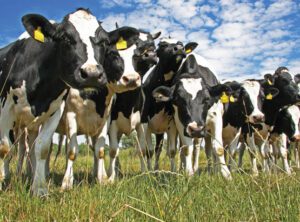Milk prices are low, but to improve dairy farm margins in challenging times, dairies should look “lower” to improve profitability — all the way down to the ground, according to Midwestern BioAg Director of Nutrition Dave Meidl.
“If you grow your own forages,” says Meidl, “we can help you improve profitability by building a fertility plan to grow a better quality, higher-yielding crop. There’s a lot of revenue potential in the soil, and we can help you unlock it.”
By taking a systems-approach to dairy farm management, consultants like Meidl can help farmers grow better quality, higher-yielding forages and reduce supplemental mineral costs.
Wayside Dairy near Green Bay, Wisconsin, works closely with BioAg consultant Terry Dvorachek to build farm profitability from the ground up. With Meidl’s help, Dvorachek put together a fertility program to improve financial returns from Wayside Dairy’s forages. With their top-quality genetics and close attention to detail, “it has been a real honor to work with Dan and Paul Natzke,” notes Dvorachek, who has worked with the 1,750-cow dairy since 2012.
Working with BioAg consultant Terry Dvorachek, Wayside Dairy saved 13 cents per cow per day on supplemental mineral.
A family operation for more than 150 years, Wayside Dairy is always in search of tools to help them improve their 2,600-acre farm. “We are progressive dairymen and we want to have our soil as healthy as we can,” says Dan. “By being good stewards of our land, we can provide more nutritious food for our cattle and also leave behind a better farm for the next generation.”
Wayside Dairy relies on BioAg’s soil fertility program to enhance their forages and make them more profitable. They have also implemented management practices like cover crops to help them build soil health.
“We plant about 280 acres in triticale each year following corn silage harvest,” says Dan. “In the spring, we apply liquid manure and harvest the crop for our heifers and dry cows.” After harvest, Wayside Dairy follows with no-till corn.
Earlier this spring, the Natzkes averaged 4 tons (wet) per acre from their triticale crop. “If you’re a dairy farmer, don’t overlook cover crops as a forage source,” notes Dan.
On their alfalfa, the dairy applies BioAg’s Bio-Cal® at 800 lbs. per acre and 2-4-30 fertilizer at 300 lbs. per acre.
The payoff? More milk per acre and reduced feed input costs.
“Wayside Dairy’s yields, forage samples, and soil tests are very strong,” says Dvorachek. “Their crop performance has helped them keep feed costs low without sacrificing production.”
Returns on Midwestern BioAg’s forage program are threefold:
- Reduced feeding costs: Working with Midwestern BioAg and Dvorachek, Wayside Dairy saved 13 cents per cow per day on supplemental mineral. Out-of-pocket costs for mineral are lower because forage tests show that the mineral content of Wayside Dairy’s homegrown forages has improved. “This is important,” says Dvorachek, “because minerals in plant form are more bioavailable to the cow than supplemental minerals added in rock form.”
- More feed: Using products like Bio-Cal and BioAg’s balanced fertilizers, Wayside Dairy has improved forage yields from 3.7 tons per acre to 4.2 tons per acre. With a larger feed inventory on the farm, Wayside can devote less acreage to hay production so that other crops can be grown or herd size can be increased without buying or renting additional land. And, in some cases, extra hay can be sold as secondary income.
- Better economic return per acre: Using the University of Wisconsin Extension’s Milk 2006 program, Wayside Dairy’s BioAg-fertilized hay ground showed higher total digestible nutrients of dry matter over the control (63.2 versus 61.6), higher relative forage quality (164 vs. 158), and more milk per ton (3,013 vs. 2,903). Milk per acre was higher as well (12,777 vs. 10,828).
Overall, Wayside Dairy gained $300 more per acre in milk income by applying the BioAg forage program on their hay ground.

“That’s a pretty nice return on investment,” noted Meidl. “Even in the face of low milk prices, we can help dairies improve their bottom line. The proof,” says Meidl, “is in the numbers.”
Wayside Dairy takes those numbers seriously. When asked what advice he might give other farmers looking to improve their bottom line, Dan suggested looking for an outside opinion. “We use a lot of consultants — really good people who can take us to that next level,” says Dan. “Good consultants can help you do what you are already doing even better.”

